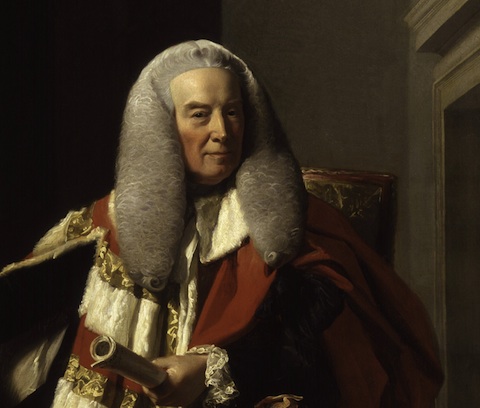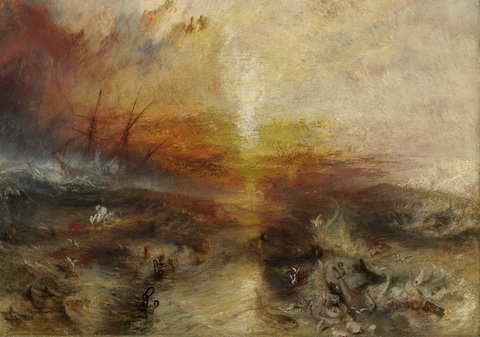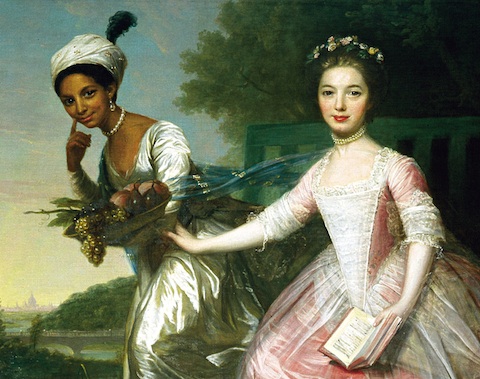Lord Mansfield, the Somerset case and the Zong massacre

Lord Mansfield was the adoptive father of Dido Elizabeth Belle, the daughter of a slave and perhaps an inspiration for the character of Fanny Price IN Mansfield Park. (More below)
From 1756 to 1788 Lord Mansfield was also Chief Justice of the Court of King’s Bench, the highest court in Britain. As Chief Justice he was called upon to decide two landmark cases relating to slavery and the slave trade.
Although Mansfield had ruled narrowly that once a slave was free, even if he had escaped, he could not be re-enslaved (a precedent set by Mansfield’s court the previous year in the case Rex v. Stapylton) the Somerset decision was widely interpreted as outlawing slavery in Britain. Mansfield, aware of the ambiguity of slavery’s status after his decision and concerned for the fate of his adoptive daughter, made sure to write explicitly in his will that “I do confirm to Dido Elizabeth her freedom.”
The Somerset case, 1772: James Somerset (or Somersett) was a slave purchased in the American colonies and brought to England, where he escaped. During his brief time of freedom, Somerset was baptized in the presence of three witnesses who stood as his godparents. Somerset was recaptured and imprisoned on board a ship that was bound for Jamaica, where he was to be sold. But before the ship could sail, Somerset’s godparents filed a writ of habeas corpus with the Court of the King’s Bench. He was taken off the ship and freed on his own recognizance while arguments in the case were heard.
Lord Mansfield found that the laws governing slavery in the American colonies did not hold in Britain:
The state of Slavery is of such a nature, that it is incapable of being now introduced by courts of Justice upon mere reasoning, or inferences from any principles natural or political; it must take its rise from positive law;…and in a case of so odious a nature as the condition of slaves [the law] must be taken strictly.
…[N]o master ever was allowed here to take a slave by force to be sold abroad because he had deserted from his service, or for any other reason whatever…therefore the man must be discharged.
Although Mansfield had ruled narrowly that once a slave was free, even if he had escaped, he could not be re-enslaved (a precedent set by Mansfield’s court the previous year in the case Rex v. Stapylton) the Somerset decision was widely interpreted as outlawing slavery in Britain. Mansfield, aware of the ambiguity of slavery’s status after his decision and concerned for the fate of his adoptive daughter, made sure to write explicitly in his will that “I do confirm to Dido Elizabeth her freedom.”
The Zong Case

In late November and early December 1781 the captain and crew of the slave ship Zong, with fresh water running low and disease spreading among the 440 slaves on board (it was later claimed that 60 of them had already perished), threw more than 130 slaves overboard to their deaths. The ship’s owners then made an insurance claim under the maritime principle of “jettison”: in extremity some cargo could be sacrificed in order to save the rest.
In 1783 a jury, hearing the case under Lord Mansfield’s supervision, ruled that the insurers should reimburse the ship’s owners for the dead slaves. The insurers appealed to the Court of King’s Bench, which was also presided over by Lord Mansfield. Mansfield noted that the legal precedent for treating slaves as property was well established:
The matter left to the jury was, whether it [the killing of the slaves] was from necessity: for they [the jury] had no doubt (though it shocks one very much) that the case of slaves was the same as if horses had been thrown overboard. It is a very shocking case.
“Though it shocks one very much…It is a very shocking case.” As in the Somerset case when he referred to the condition of slaves as “odious,” Mansfield here seems to be signaling his own feelings about the treatment of slaves. However, as in the Somerset case, he felt constrained to rule on the narrow basis of firmly established legal precedents: in the Zong case, those governing the insurance of slaves as property.
The insurers’ lawyers made two main arguments. One was that the only reason the water supplies were depleted on the Zong was as a result of the errors of the captain and crew: they had bypassed opportunities to resupply during the voyage, and had overshot their destination, Jamaica, by 300 miles. If the captain and the crew were at fault, the insurers should not be liable.
Another argument was that no “necessity” existed. Slaves had been thrown overboard on three different days; however, after the second group had been killed, a rainstorm broke, and the ship was able to substantially replenish its water supplies. Even so, that did not stop the killings: the day after the rainstorm, another group of slaves were thrown overboard.
This was information that had not come out at the first trial; as Mansfield said, “it is new to me. I did not know any Thing of it.” If no “necessity” existed, the insurers’ lawyers argued, then the actions of the crew were mass murder: “a Crime of the Deepest and blackest Dye.”
The lawyers used the word “murder” repeatedly. Granville Sharp, who was advising the insurers’ legal team, had been alerted to the Zong case by the antislavery campaigner and former slave Olaudah Equiano and had earlier advocated, unsuccessfully, for murder charges to be brought against the ship’s officers and crew. Sharp was clearly working with the insurers’ lawyers to try to introduce these charges into the appeal proceedings. Solicitor General John Lee, who was defending the appeal case for the owners, attempted to dismiss this argument:
What is this claim that human people have been thrown overboard? This is a case of chattels or goods. Blacks are goods and property; it is madness to accuse these well-serving honourable men of murder. They acted out of necessity and in the most appropriate manner…The case is the same as if wood had been thrown overboard.
However, Mansfield and the two other judges on the Court of King’s Bench did not accept Lee’s arguments. While they did not void the ability of slave-ship owners to insure human beings as property, they overturned the jury’s decision in favor of the ship owners and ruled that a new trial was called for. But no retrial was held, apparently; the owners may simply have dropped their claim in order to avoid the negative attention garnered by the case.
Lord Mansfield, Jane Austen and the anti-slavery movement
Although the conservative Mansfield was himself not an abolitionist, these two cases made his name a watchword among the British anti-slavery movement. One member of that movement, the poet William Cowper, wrote in The Timepiece, Book II of The Task (1785), what seems a clear reference to Mansfield’s decision in the Somerset case:
Slaves cannot breathe in England; if their lungs
Receive our air, that moment they are free,
They touch our country and their shackles fall.
Cowper was Jane Austen’s favorite poet, according to her brother Henry. There are allusions to Cowper in several of Austen’s novels; in Mansfield Park Fanny Price says to Edmund Bertram when she hears of Mr. Rushworth’s plans to cut down an avenue of trees on his estate,
“Cut down an avenue! What a pity! Does it not make you think of Cowper?
‘Ye fallen avenues, once more I mourn your fate unmerited.’”
The quote is from The Sofa, Book I of The Task. Clearly Fanny is in sympathy with Cowper’s opposition to all arbitrary and unjust exercise of power.
Another of Austen’s favorite authors was abolitionist Thomas Clarkson, whose History of the Rise, Progress and Accomplishment of the Abolition of the African Slave Trade was published in 1808, the year after Parliament passed “An Act for the Abolition of the Slave Trade” in the British Empire. This act did not abolish slavery itself, however. “An Act for the Abolition of Slavery throughout the British Colonies” was not passed until 1833 and did not take full effect until 1840; even then, exceptions were made for India, Ceylon, and the island of Saint Helena off the west coast of Africa. So at the time of Mansfield Park slavery was still widespread in the British Empire, and particularly in the West Indies.
Why is this significant for a discussion of Mansfield Park? Because Sir Thomas Bertram, owner of the Mansfield Park estate, also owns a plantation in Antigua; Sir Thomas is a slaveowner.
Fanny Price & Dido Elizabeth Belle

A young girl whose parents are not able to raise her advantageously is sent to live with her wealthy relatives. There she is brought up and educated as though she were their daughter.
This is the story of Fanny Price in Mansfield Park (1814); it is also the real-life story of Dido Elizabeth Belle, the young woman with the lively, impish expression on the left in the portrait above. Dido was the “natural child” of Captain John Lindsay and a West Indian slave named Maria Belle, or Bell. Dido had been born in 1761 in the Caribbean, where Lindsay’s ship HMS Trent had been stationed during the Seven Years’ War (Maria Belle may have been imprisoned on a Spanish slave ship captured by HMS Trent). After the war’s end, Lindsay returned to England with Maria and his young daughter, and transferred the girl to the care of his childless maternal uncle and his wife.
Her adoptive parents christened her Dido (the name of the mythological queen of the North African city-state of Carthage). At about the same time they also adopted Dido’s cousin Elizabeth Murray, whose mother had recently died. They raised the two girls together on terms of equivalence, if not quite of equality (note that in the portrait both women look forthrightly at the viewer, and that their heads are at the same level). The exact nature of the girls’ relationship is not known, but from the evidence of the portrait and the account of a contemporary visitor who wrote that Dido “walked with the company in the gardens, one of the young ladies having her arm within the other,” it seems to have been loving and sisterly.
The Oxford Dictionary of National Biography states that Dido “held a position balanced between family member and servant and was in charge of the dairy and poultry yard,” but that status would not explain why she was taught to read and write; provided with a substantial allowance, expensive furniture, and gifts; and why her adoptive father was said to dote on her. The 2007 Slavery and Justice Exhibition at Kenwood House suggested that “her position in the household may have been that of a loved but poor relation”—much like Fanny Price at Sir Thomas Bertram’s estate, Mansfield Park.
The name of Dido’s adoptive father was William Murray, Lord Mansfield.
In August 1805, Elizabeth, now Lady Elizabeth Finch-Hatton, was visited at her home Eastwell Park in Kent by her neighbor Edward Knight and a family party that included his visiting sister. Although the sister was delighted with Lady Elizabeth’s sons, she was unimpressed by their mother, writing in a letter, “I have discovered that Lady Elizabeth, for a woman of her age and situation, has astonishingly little to say for herself…”
Perhaps Edward Knight’s sister, Jane Austen, would have more thoroughly enjoyed conversation with Dido. But by this time, Dido had died; she too had married (though to a man much lower on the social scale than Elizabeth’s husband) and had children, but had passed away in 1801. Despite their overlapping family connections—the Hattons were relatives of the Bridges who were relatives of the Knights who were relatives of the Austens—there is no evidence that Jane Austen ever met Dido. But she almost certainly knew her story, and from the evidence of Mansfield Park, adopted elements of Dido’s situation in creating her heroine Fanny Price.







